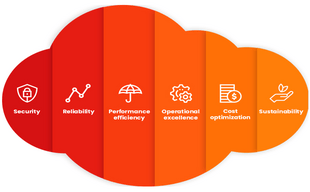Optimize cloud spending and save on costs without sacrificing performance and reliability.
What is AWS Well-Architected Framework Review (WAR) Assessment?
AWS Well-Architected Framework Review Assessment is a comprehensive review of your cloud infrastructure, based on AWS best practices and security standards. It helps you identify areas of improvement and implement best practices to optimize your architecture for cost, performance, security, reliability, and operational excellence.
Why Focus on Cost Optimization?
- Rightsize instances and resources to avoid underutilization or overprovisioning
- Leverage AWS pricing models and services to optimize costs
- Implement automation and governance to manage costs proactively
- Identify and reduce waste and unused resources
Book A Cost Optimization Audit Now
How AWS WAR Assessment Can Help You?

Understand your business needs and cloud objectives

Analyze your workload and architecture based on the five pillars of AWS Well-Architected Framework

Provide recommendations and a roadmap to optimize your architecture for cost

Implement best practices and optimize your infrastructure over time

Monitor and report on cost savings and ROI
Trusted by Leaders & Pioneers
Benefits of AWS WAR Assessment
Reduce cloud spending by up to 30%
Improve cloud performance, reliability, and security
Align cloud architecture with industry best practices
Gain insights and visibility into cloud environment
Enhance team's cloud skills and knowledge
Six Pillars of AWS WAR Assessment

Operational Excellence

Security

Reliability

Performance Efficiency

Cost Optimization

Sustainability
Success Stories
100+CLIENTS
HOW DO I GET STARTED?
Get in touch with our AWS CLOUD CONSULTANT to get best in class multi-cloud expertise.
Talk to an expert today!
FAQ
What is AWS Well-Architected Review?
During a Well-Architected Review, an AWS Solutions Architect will work with you to review your workload against the five pillars of the framework: Operational Excellence, Security, Reliability, Performance Efficiency, and Cost Optimization. The review aims to help you identify any potential issues or areas of improvement and to provide recommendations on how to address them.
Once the review is complete, you will receive a report that summarizes the findings and provides actionable recommendations. The report also includes a roadmap that can help you prioritize your actions and implement the recommendations over time.
When should I perform a Well-Architected workload review?
1. Before deploying a new workload: If you are planning to deploy a new workload in the cloud, you can perform a Well-Architected Review to ensure that your architecture aligns with the best practices and principles of the AWS Well-Architected Framework.
2. After a significant change: If you have made a significant change to your workload, such as adding new features, changing infrastructure, or updating software, you can perform a review to ensure that the changes align with the best practices of the framework.
3. On a regular basis: You can perform regular Well-Architected Reviews to ensure that your workload remains optimized, secure, reliable, and cost-effective over time. You can schedule these reviews annually, quarterly, or even monthly, depending on your workload's complexity and criticality.
4. During a migration: If you are planning to migrate an existing workload to the cloud, you can perform a review to ensure that the migration aligns with the best practices and principles of the framework.
In summary, you can perform a Well-Architected Review at any stage of the workload's lifecycle, depending on your organization's needs.
What are the benefits of AWS Well-Architected Review?
1. Increased reliability: The review helps you identify potential issues in your workload architecture that could impact its reliability. By addressing these issues, you can improve the workload's uptime and reduce the risk of service disruptions.
2. Improved security: The review helps you identify potential security risks and vulnerabilities in your workload architecture. By addressing these issues, you can improve your workload's security posture and reduce the risk of security breaches.
3. Increased performance and efficiency: The review helps you identify potential bottlenecks and inefficiencies in your workload architecture. By addressing these issues, you can improve the workload's performance and efficiency, which can result in better user experiences and reduced costs.
4. Cost optimization: The review helps you identify opportunities to optimize costs by eliminating unnecessary resources, rightsizing your infrastructure, and leveraging AWS services that can help you save money.
5. Expert guidance: The review provides you with expert guidance from AWS Solutions Architects who have deep expertise in designing and optimizing workloads in the cloud. Their recommendations can help you improve your workload architecture and optimize its performance, security, reliability, and cost-effectiveness.
Overall, the AWS Well-Architected Review can help you optimize your workload for the cloud, improve its reliability, security, performance, and efficiency, and reduce your costs.
What the cost benefits of doing a Well-Architected Review?
1. Reduced infrastructure costs: The review helps you identify opportunities to optimize your workload's infrastructure by rightsizing resources, eliminating unused or unnecessary resources, and using the right AWS services to meet your workload's needs. By implementing these optimizations, you can reduce your infrastructure costs and save money.
2. Improved resource utilization: The review helps you identify potential bottlenecks and inefficiencies in your workload's architecture. By addressing these issues, you can improve your workload's resource utilization, which can result in better performance and lower costs.
3. Increased cost predictability: The review provides you with a roadmap that outlines the recommended improvements and their estimated costs. This can help you plan and budget for the necessary changes, which can increase cost predictability and reduce the risk of unexpected expenses.
4. Avoidance of unnecessary costs: The review helps you identify potential risks and issues that could result in downtime, data loss, or other costly events. By addressing these issues, you can avoid the associated costs of these events.
5. Optimized cost structure: The review provides you with recommendations on how to leverage AWS services to optimize your cost structure. This can help you take advantage of AWS pricing models, such as Reserved Instances or Savings Plans, to reduce your costs and save money.
Overall, performing an AWS Well-Architected Review can help you optimize your workload's cost structure and reduce your infrastructure costs, while also improving its reliability, security, and performance.





















